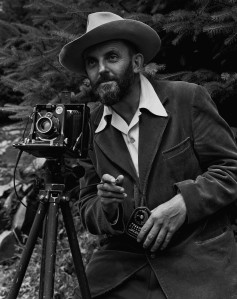Ansel Adams (February 20, 1902 – April 22, 1984) is an American icon, one of the first to paint poetry in black and white photos. He is also the one many "purist" photographers point to when discussing their dislike of today's use of digital work in creating artistic photography. But if one spends time studying Adams life, it becomes harder to use him as a purist role model.
Adams pioneered the use of light as a main influence in his photographs, and experimented with all the technical equipment which was available to use during his day. He started with a small, poorly equipped darkroom in his parent's basement, but his wife's family, who had a business publishing photography, was one of the first to publish his prints and later, the business was passed on to him. He took full advantage of the darkroom, experimenting and producing much of the work which has made him well known to most Americans, and also pushed him onto the international arena.
It is easy to take a photograph, but it is harder to make a masterpiece in photography than in any other art medium. (Adams, Ansel (1985). Ansel Adams, an Autobiography. Boston: Little, Brown. ISBN 0-8212-1596-5.)
His legacy includes helping to elevate photography to an art comparable with painting and music, and equally capable of expressing emotion and beauty. (see above source) Adams used a variety of lenses to get different effects, but eventually rejected pictorialism for a more realistic approach which relied more heavily on sharp focus, heightened contrast, precise exposure, and darkroom craftsmanship. (Alinder, Mary (1996). Ansel Adams: A Biography. New York: Henry Holt and Company). In other words, he did in the darkroom what DSLR photographers can now do in the camera, as well as with computer programs such as Photoshop and Topaz.
The initial publication of Adam's Moonrise was in U.S. Camera 1943 annual, after being selected by the "photo judge" for U.S. Camera, Edward Steichen.[52] This gave Moonrise an audience before its first formal exhibition at the Museum of Modern Art in 1944. Over nearly 40 years, Adams re-interpreted the image, his most popular by far, using the latest darkroom equipment at his disposal, making over 1,300 unique prints, most in 16″ by 20″ format. ("5 prints of "Moonrise", 1941–1975". Andrew Smith Gallery.)
To an artistic photographer, then, Ansel Adams now becomes a role model. I started out many years ago learning rudimentary darkroom skills and now I use the techniques afforded me by today's technology. It's very hard for some people to be fluid enough to accept new ways of doing things, even to simply acknowledge that the new ways are an authentic tool. It's acceptable that many photographers like to continue in what they know and do best, and perhaps they do not wish to try it a different way. That is fine, each has their choice. But those who then go on to say that their choice is the only legitimate one has effectively portrayed themselves as lost to the past, and are insulting to those who choose to use a new way of expressing the poetic beauty from inside their spirit.
Enjoy your life one day at a time!


No comments:
Post a Comment
Hi! Please leave a comment - they mean a lot.
Thanks for coming by to visit!